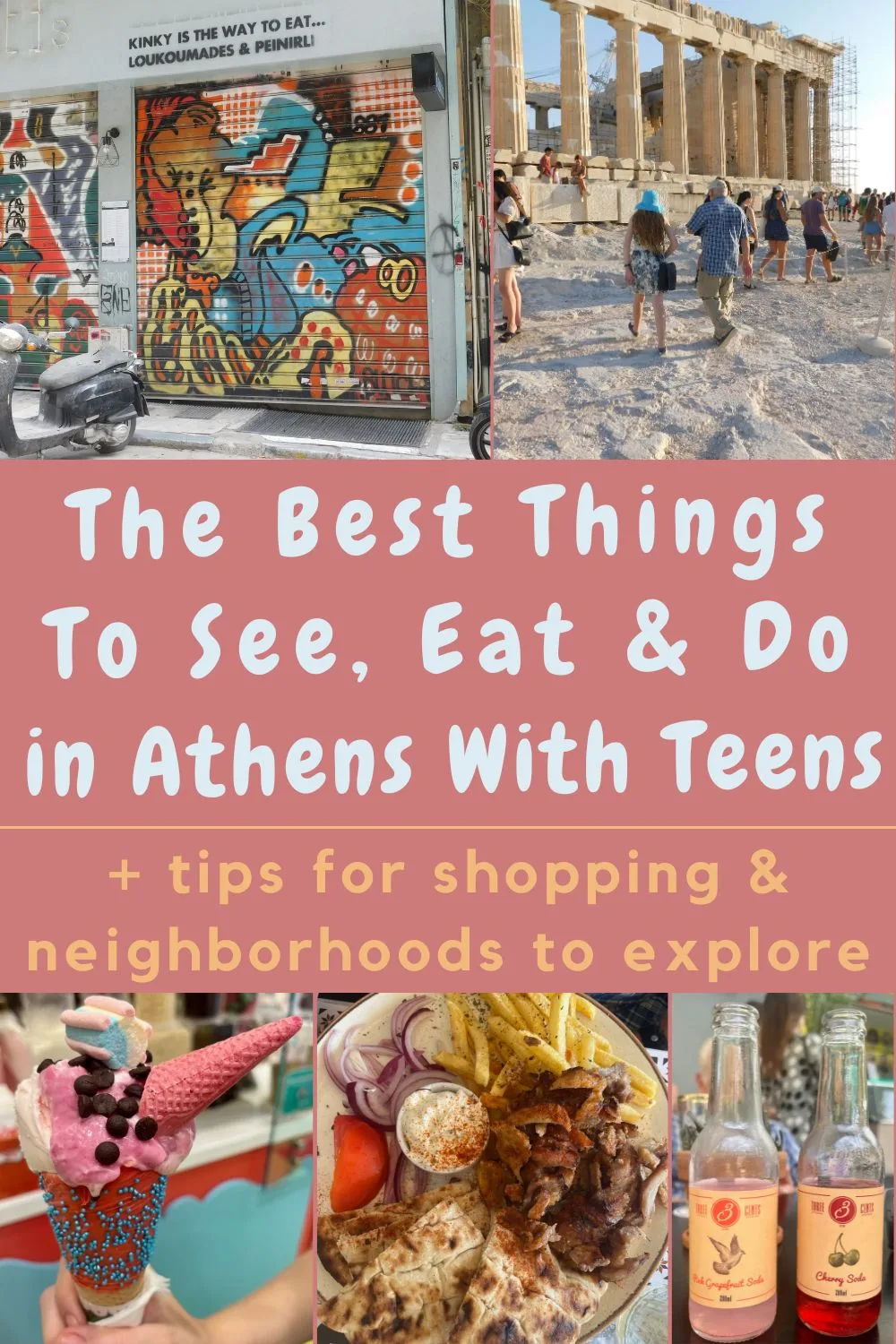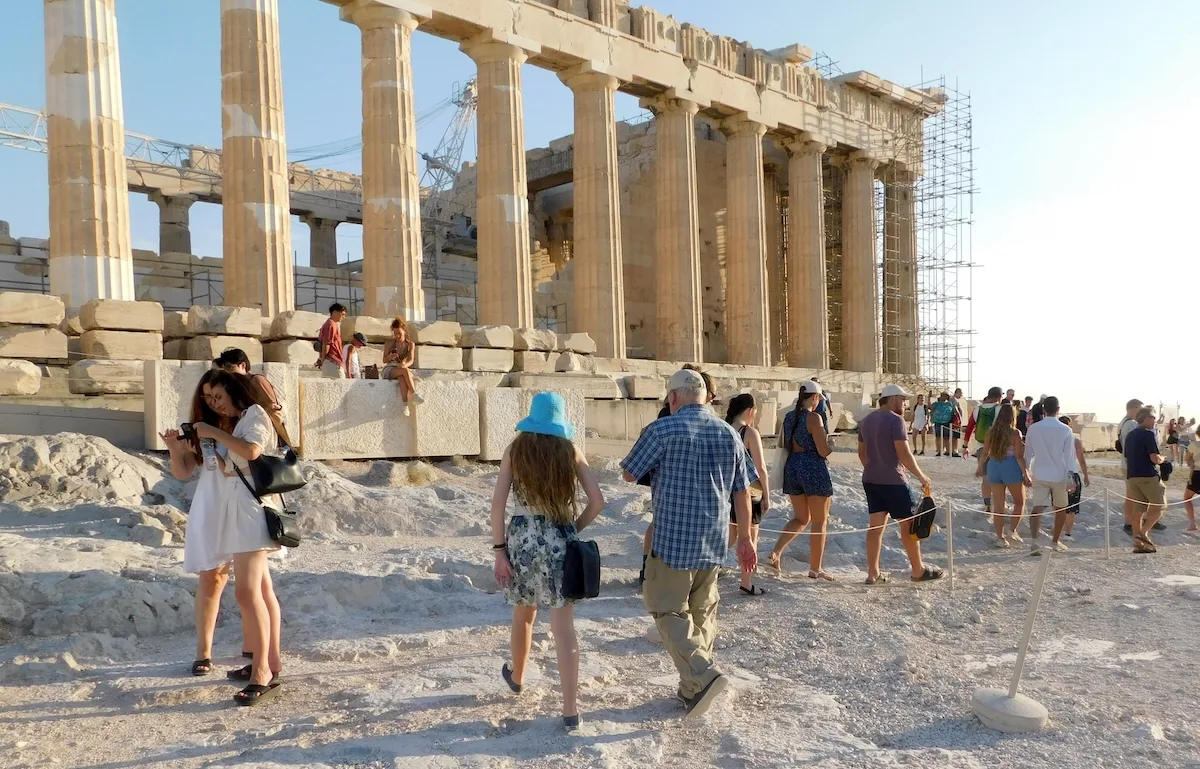People flock to Athens every summer because, on a continent full of old buildings and history, this Greek city offers some of the most iconic and ancient. But spending all your days touring ruins and museums is a good way to bore the heck out of kids and even teens. You need kid-friendly ways to see the historic sights and other things to do in between.
We spent four days in Athens in hot, crowded August, at the tail end of our Mediterranean cruise on Holland America’s Oosterdam.
Here are the things we did with our teen, including ruins you can’t miss, neighborhoods to explore and good things to eat. I also have some suggestions for things we could have done better.
I hope it helps you to plan your own family vacation in this unique, historic city.
Read more:
• About the three nights we spent in Venice before the cruise.
• About our first two port days in Split and Korcula, Croatia
• About our next stops on the Greek islands of Santorini & Rhodes
• About our last stop in Kusadasi, Turkey
•
This article is now featured on GPSmyCity. To download it or offline reading or create a self-guided walking tour, go to Walking Tours and Articles in Athens. Or read it in the app.
Tips For Finding A Family-Friendly Hotel in Athens
Trawling Expedia for hotels three months before our trip, I was looking for a major hotel brand that I could trust to have good air conditioning. And I wanted a pool.
I found small local hotels that were well-located but expensive and somewhat basic. I also found bigger hotels from brands I know, but most engaged in the magical thinking that it’s possible to sleep three people in a room with one bed and no pull-out sofa.
Eventually, I found the Wyndham Grand Athens, which had the most important things we wanted, at a reasonable room rate.
The Wyndham had a lovely rooftop pool, where we took a break to swim every afternoon.
We had an air-conditioned family-size room with a queen bed and a full-sized pull-out bed with a latticed wooden room divider in between. We all had a bit of privacy and room to spread our stuff out, and we never felt on top of each other.
There was a Metro station less than one block away. From there we could get to anywhere we wanted to in twenty minutes or less.
We also had both a large café/bakery and a lively taverna with good food right across the street.
The hotel’s rooftop restaurant/bar served breakfast, but as usual, we skipped the overpriced hotel breakfast in favor of local coffee and baked goods. But more than once we stopped by for late-afternoon drinks with a Parthenon view.
On the downside, we thought the hallways were due for refurbishment and the elevators were slow, but those are quibbles. The real trade-off for all the pluses was being in Metaxourgeio, which was further than we expected from the city’s tourist center.
It had blocks that were bustling on weekdays and blocks with empty buildings. It was a bit foreboding on the Sunday we arrived, when businesses were closed.
If you want to have all the main tourist sites and more dining options just steps from your hotel, look for a room in Plaka, Psirri or Monastiraki; just be prepared for hotels that are either very basic or fairly expensive.
Funky Exarchia seems to be a hot spot for vacation rentals. It’s a few short blocks from the Omonia metro station, where the green and red lines meet; everything we did was one of these lines.
Athens vacation planning Cheat Sheet
Best Hotel for large rooms and a pool: Wyndham Grand Athens
• Save money with airfare-and-hotel packages on Expedia.
• Can’t Miss Attraction: The Acropolis and the Parthenon
• Best Splurge: Driving to Sounio to see the Temple of Poseidon at sunset.
• Hire Welcome taxi for a personal day or nighttime tour of the city or to drive to Sounio. We had a great experience with them in Santorini.
• Offbeat Neighborhood to Explore: Exarchia for cool cafés, boutiques and street art
• Ice cream your kids will love: Hans & Gretl in Monastiraki
Best al fresco dinner spot: Diogenes in Plaka
13 Things To Do In Athens With Teens On A 4-Day Visit
The Ruins You Can’t Miss
There are a lot of ruins in Athens, some more completely ruined than others. You’ll get ruin-fatigue before you’ve seen even half of what you could, and your kids will tire of them long before you do. So prioritize and start with the most interesting ones and famous ones.
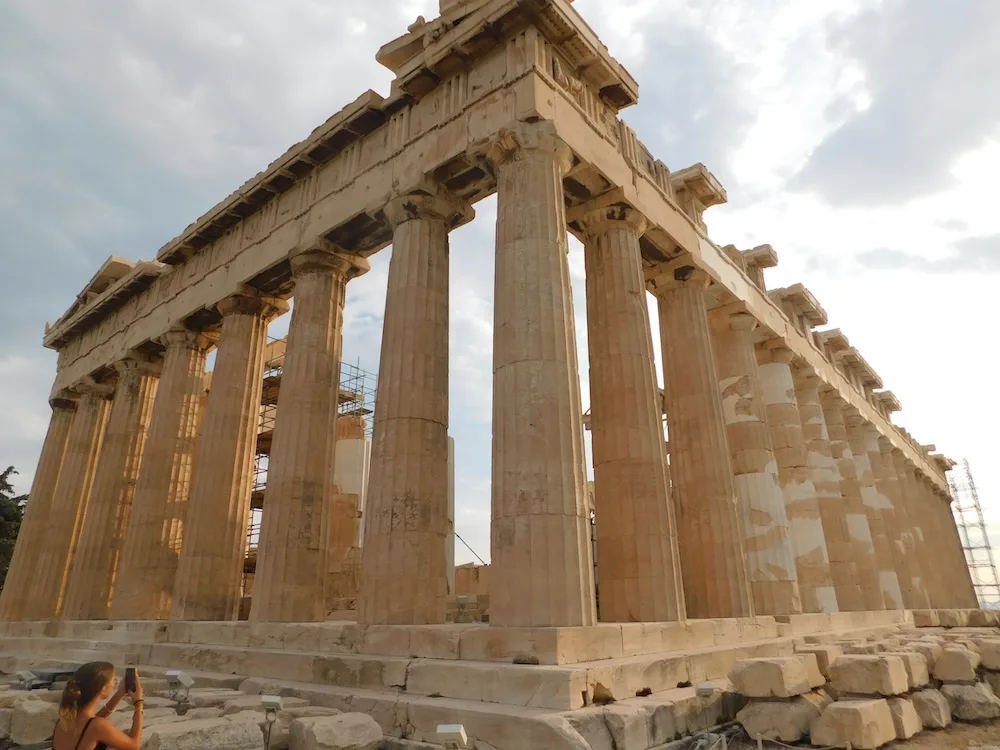
The Acropolis
Needless to say, start with the Acropolis and its famous Parthenon and shapely Korai pillars. This complex has a lot to see, including two amphitheaters (one still in use; see if anything is on while you’re there!) and several other structures on the way up the hill and around the top of it.
This is one of those places where you should absolutely spring for a guided tour. It helped to have a person to provide context and to tie the myriad ruins dotted all over this hill to both history and Greek mythology. Our guide was good at engaging the three school-age kids on our tour, while still being informative enough for the adults and our teen.
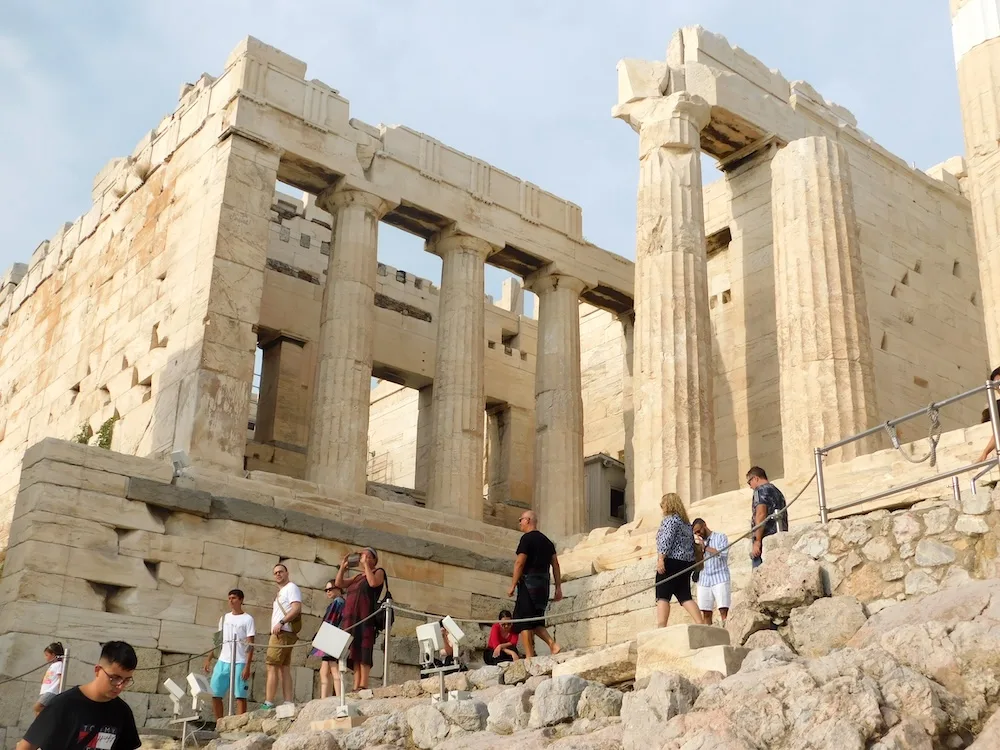
Better still, having a guide gives you a chance to catch your breath as they pause to explain things on the way up.
On the advice of a friend who had traveled to Athens a few weeks before us, we booked an evening tour. After 5:00, the day starts to cool off and the crowds start to thin. (In the morning the crowds and the heat both build quickly).
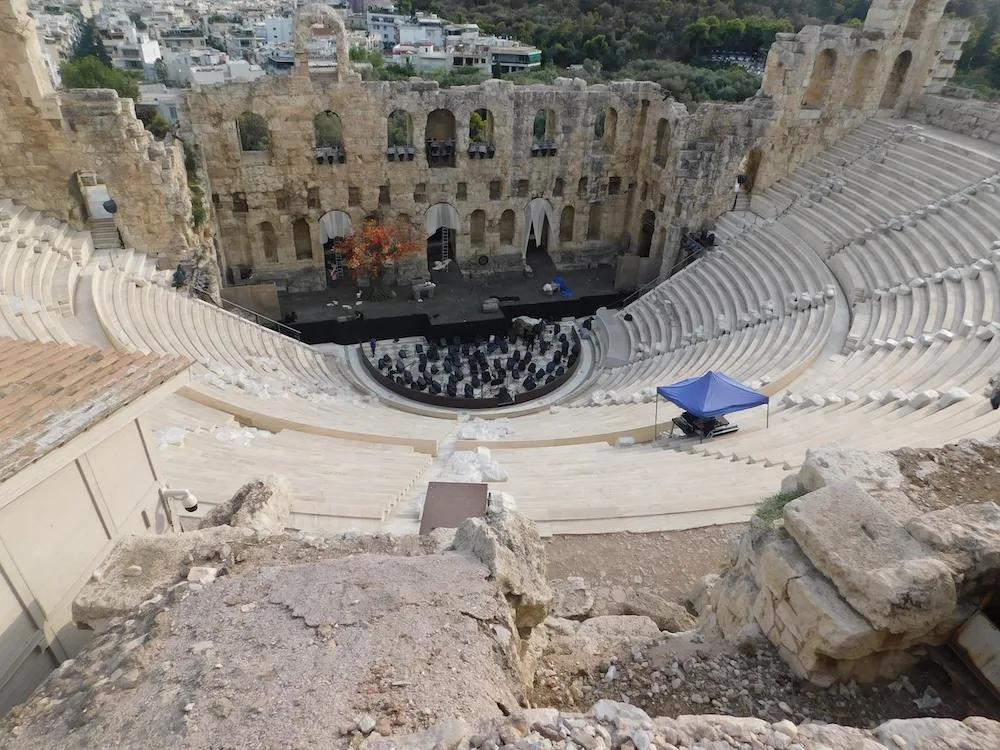
You can also stay to watch the sunset through the Acropolis’s marble gates, which many people did. Just be prepared to walk back down as it’s getting dark, which takes some care.
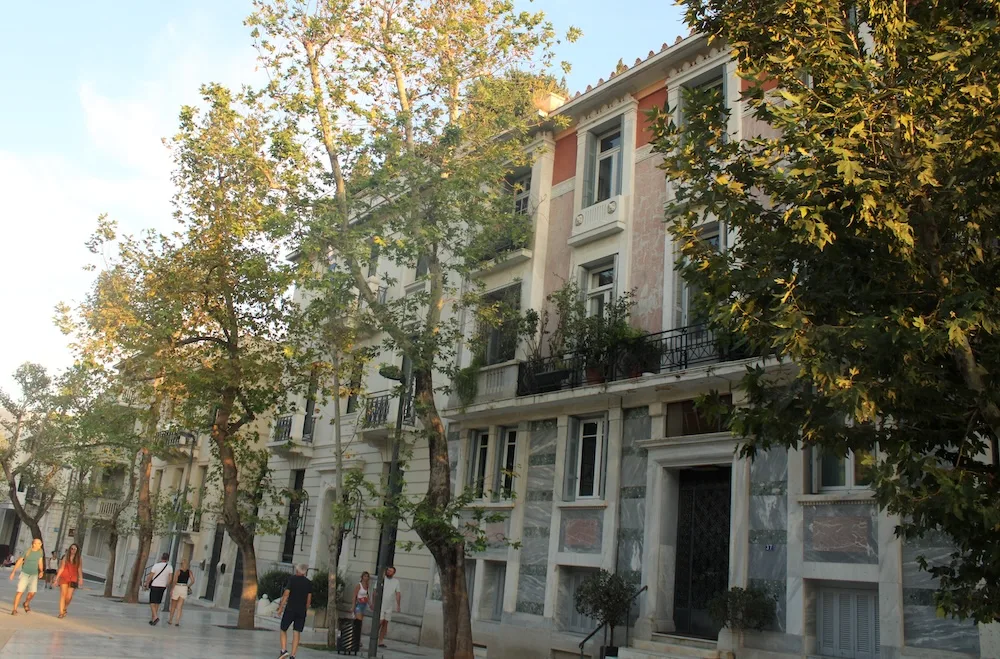
You exit the Acropolis on Dionysiou Areopagitou, a wide pedestrian zone. It has a lot of nice townhouses, a couple of consulates and usually a few buskers. It’s a fun street and I enjoyed making our way along it.
A bonus of the evening tour is that it landed us in the Plaka neighborhood at dinner time. It’s a lively neighborhood with a lot of cafés, restaurants and souvenir shops.
Poseidon’s Temple
After the Acropolis, the ruin I most highly recommend is the Temple of Poseidon, perched on a cliff over the Aegean Sea a little more than 40 miles from central Athens.
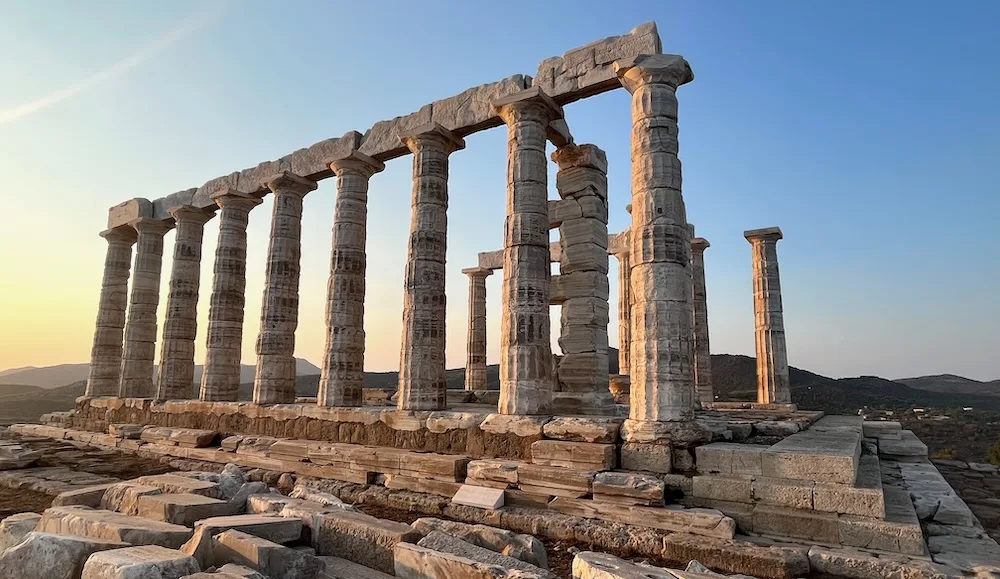
I made sure that we took this excursion because it’s the thing I remember most from my first visit to Athens thirty years ago.
This is also an evening excursion because you want to stay to see the sunset. Our photos of the Temple with the sky changing color behind it and of the sun setting over the sea are fantastic.
Be sure to put your camera down and soak up the scene, though. The temple, the cliff, the water and boats below and the changing colors in the sky are a sight you’ll remember for decades, too.
If you drive directly there, give yourselves a good 90 minutes to two hours for the drive; you can hit traffic getting out of Athens. It will take less time to get back.
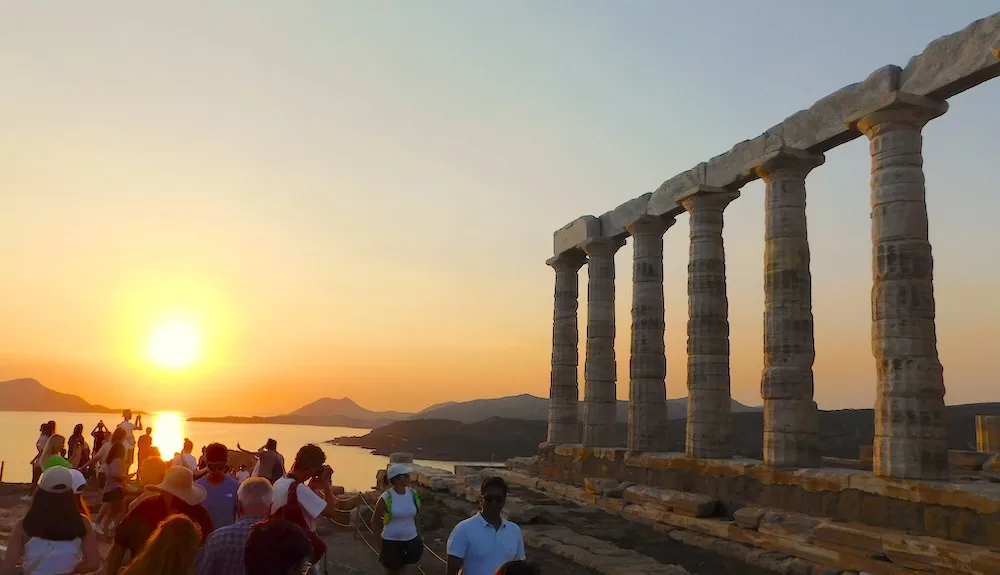
A lot of people book tours that make a few stops along the way, including time at Lake Vouliagmeni. Set into cliff walls just steps from the ocean, the lake is a soothing 80 to 85 degrees in the summer months.
We hired a guide/driver, who was really more the latter than the former. For what we paid, we would have liked more guiding. But it gave us a little flexibility as to when we left the city, when we returned and where he dropped us off afterward.
Plus, I saw several of the tour groups leaving the cape before the sun had finished setting. I think if you are going to drive all the way out there and back, you should make the most of it and catch every last second of that gorgeous sunset.
That said, if we were to do it over again, I would rent a car for the day and head out of town in the late morning to enjoy some of the many beaches along the road north of Athens.
I can’t recommend any one in particular, but most looked inviting. Some had facilities and some were just places where local people tossed a towel down and went for a swim.
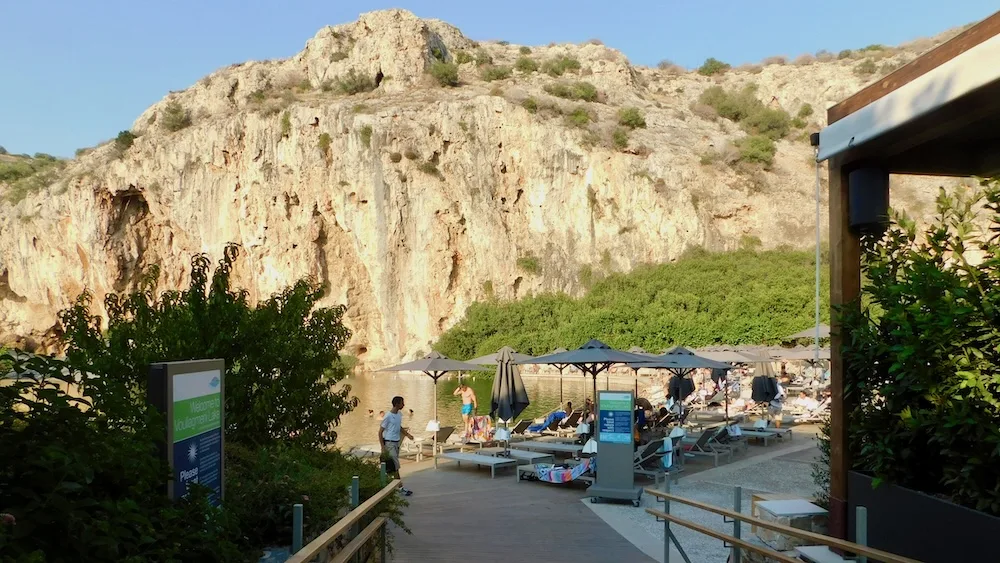
I would also consider spending time at the lake, which has a nice swimming area, café, changing facilities and a spa.
I’d have dinner on the water and then end the day at the Temple. This plan would mean driving back to Athens in the dark. But you’re largely following one road and traffic was light.
There are quite a few group tours to Poseidon’s temple; some are a half day and some a full day. They usually combine the sunset experience with time at the beach or lake, dinner and other local sightseeing.
Some Smaller Ruins
Back in the city, we went to the Ancient Agora of Athens, a large park at the foot of the Acropolis. The most interesting and intact structures include the Temple of Hephaestus, one of the best-preserved ancient temples because it was converted to a church at one point.
There is also the Church of the Holy Apostles, built around 1000 CE, when the surrounding area had a large Byzantine population. The Mediterranean architecture fits the region, but the style and the fact that it’s completely intact makes a marked contrast to the surrounding ruins. It wasn’t open to visitors when we were there; I’m not sure if it ever is.
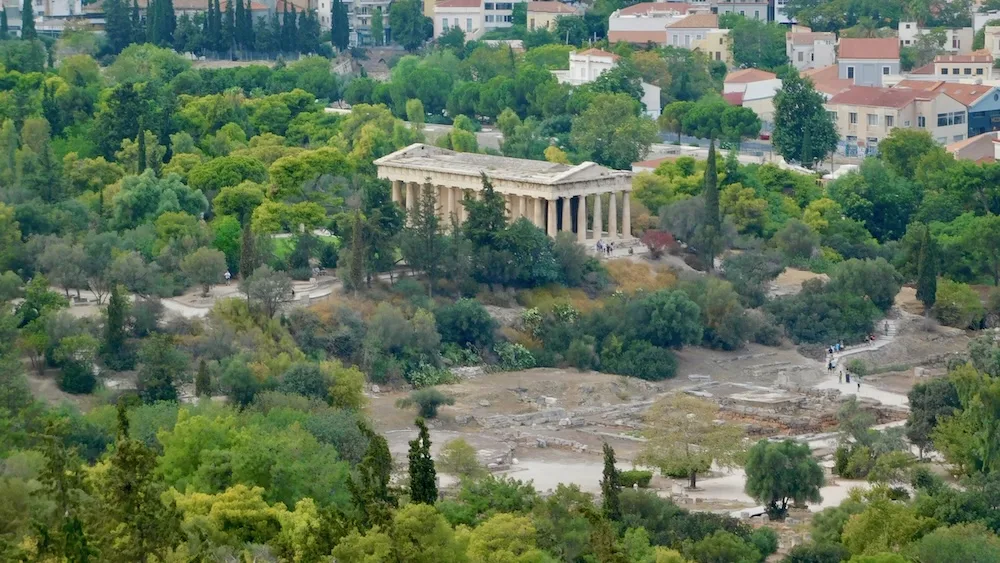
The site has had a lot of different uses over time and has a smattering of additional ruins. It’s a grassy site, where you can let kids roam free more than at any of the other sites. It’s worth seeing with school-age kids for this reason alone.
It’s worth visiting here partly because when you’re outside the gates of the Acropolis you can look down and spot the gora grounds and the temple.
We didn’t get to the Roman Agora because we got ruin fatigue before we got to it, but it’s smaller but also has an open area that has had many uses over the centuries.
We visited Hadrian’s library, at the far end of Adrianou Street from the Agora. It sounds interesting, but it was built in 132 AD and all that’s left are remnants of mosaic-tile floors and fragments of a few walls and pillars, barely enough to even imagine what it was like. I wished I’d had virtual reality goggles that would show me what it might have looked like in the emperor’s day.
Tip: Saving money on the ruins
You can buy a pass that gives you access to seven sets of ruins around the city, including the Acropolis. But the passes are €30 for adults and children over the age of 5YO. While the Acropolis is €10, most of the other sites are €4 or €5 individually. So unless you see most of them, which isn’t likely, it isn’t much of a deal.
E.U. residents up to age 25 get free admission to most sites, but they do ask for proof of citizenship.
2 Museums To Consider
There are a lot of museums in Athens. Most cover a combination of archeology, history, art and religion. On our four-day visit we only managed to get to two of them.
The Herakleidon Museum for Ancient Greek Inventions
One of our favorite activities was a visit to the Herakleidon Museum, located in two townhouses around the block from each other in Thissiou. It’s a museum that celebrates ancient Greek engineering, which really was impressive.
One part, where you pay admission, focuses on war technology and has rotating exhibits that range from Vermeer’s paintings to science and technology in ancient China.
The other part looks at engineering in everyday life in Ancient Greece and this was the cool part. There is a bisected Greek home that shows how well they mastered indoor plumbing; technology that was somehow lost for centuries.
It also has an automaton servant that can pour a glass of wine and various clever clocks, scales and self-light lamps. The is also a working reproduction of the Antikythera Mechanism, an astoundingly sophisticated astronomical clock whose fictional counterpart sent Indiana Jones back in time in the Dial of Destiny.
There are volunteer tour guides at the entrance to this part of the museum and I highly recommend letting one take you around. Ours explained why all these devices were ingenious, which added to the visit.
The whole museum took a little more than an hour to explore. We all like small, very focused museums like this. They don’t overwhelm you or take hours to see thoroughly. Teen Traveler, whose idea it was to go, thought all the gadgets were super cool.
The Acropolis Museum
We also went to the Acropolis Museum, partly because it was indoors and air-conditioned and partly because we felt we had to. It’s new, open with a lot of light and well done. There are also three floors of stone fragments with an excavated collection of house foundations beneath them.
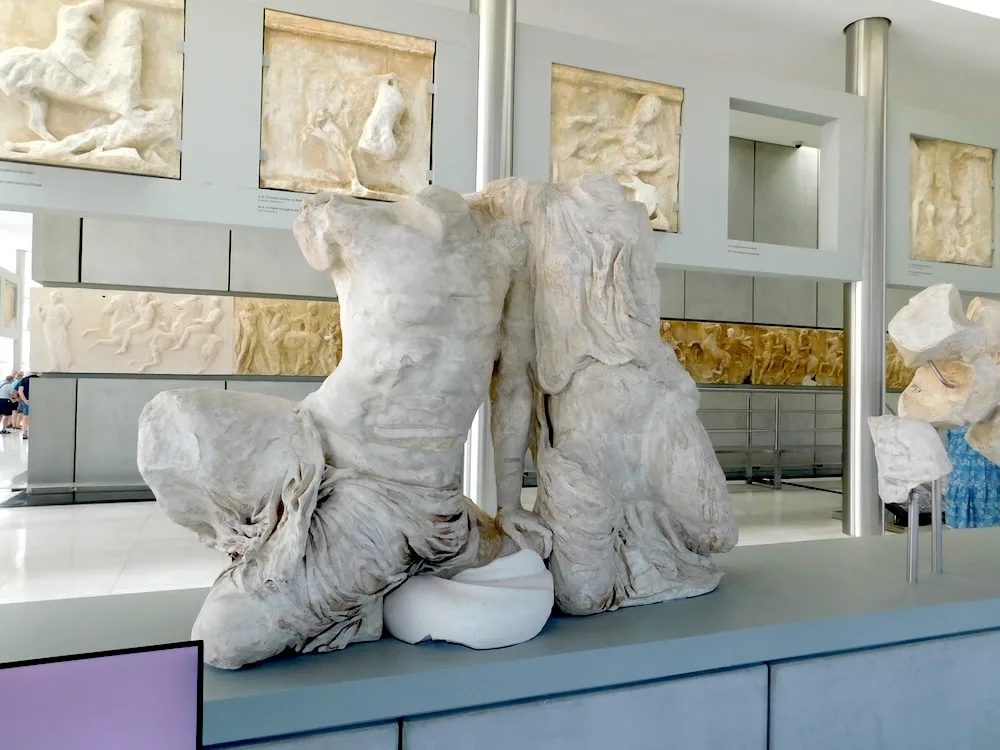
The best part is the top floor, where they have all the statues and illustrated stonework they saved from the Parthenon, mounted in the correct places in the shape of the building, so that you can get a sense of what it looked like when it was more complete.
I’ll admit we cruised through the other two floors, stopping here and there when something caught our eye. It’s a lot to take in.
Admission is one price for all non-E.U. residents and is €5 more in summer than in winter. You can find “skip the line” tickets online. But everyone has to pass through security and this is where the line is. Once inside, we didn’t have to wait to buy tickets.
3 Neighborhoods to Explore
Athens is a city with distinct neighborhoods that are worth exploring. They provide food, shopping, street art and a general break from all that history.
Anarchist Exarchia
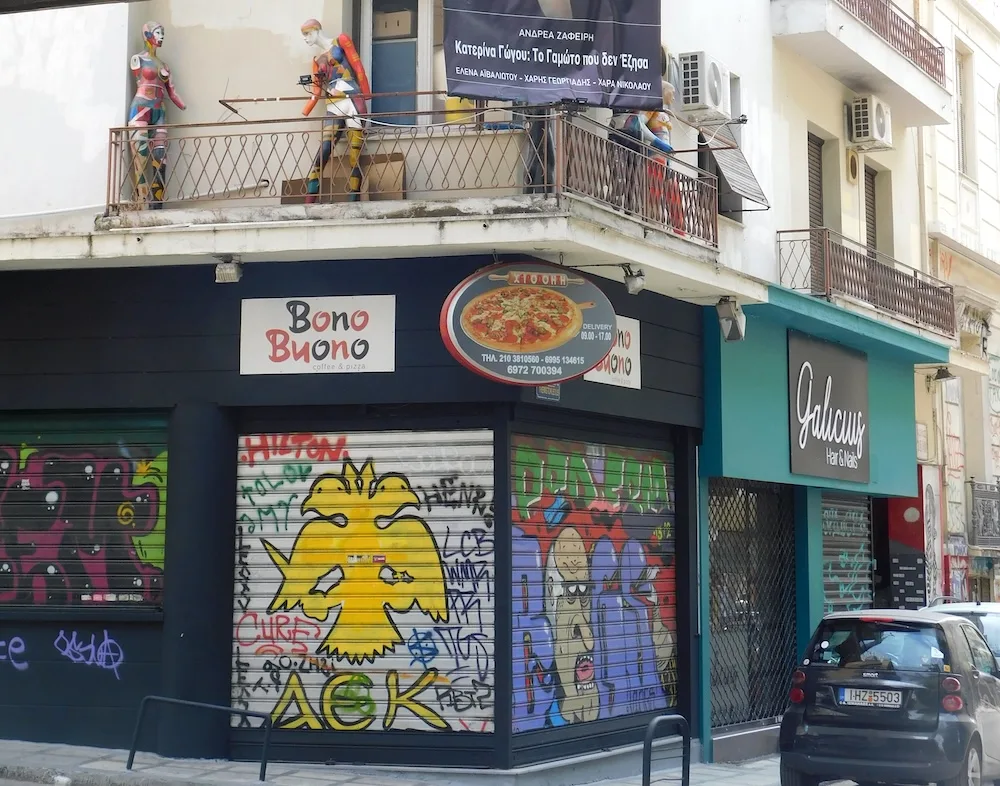
A friend with relatives in Athens sent us to Exarchia, a funky neighborhood known for being home to anarchists. There are a lot of cool murals and also plain old graffiti. Some of the latter express Exarchians’ opinions of tourists in no uncertain terms, which Teen Traveler found funny.

We walked past record shops, clothing boutiques and a bakery called Talking Breads, with a red and black logo reminiscent of Talking Heads’ album art. There are also cool bars and cafés and good, inexpensive restaurants. It’s livelier on weekdays when stores are open, and quieter on weekends.
Busy Monastiraki
Monastiraki is a neighborhood you’ll wind up in sooner or later without even trying. It has a lot of restaurants and shops. Despite it being tourist central, a lot of them are quite good.
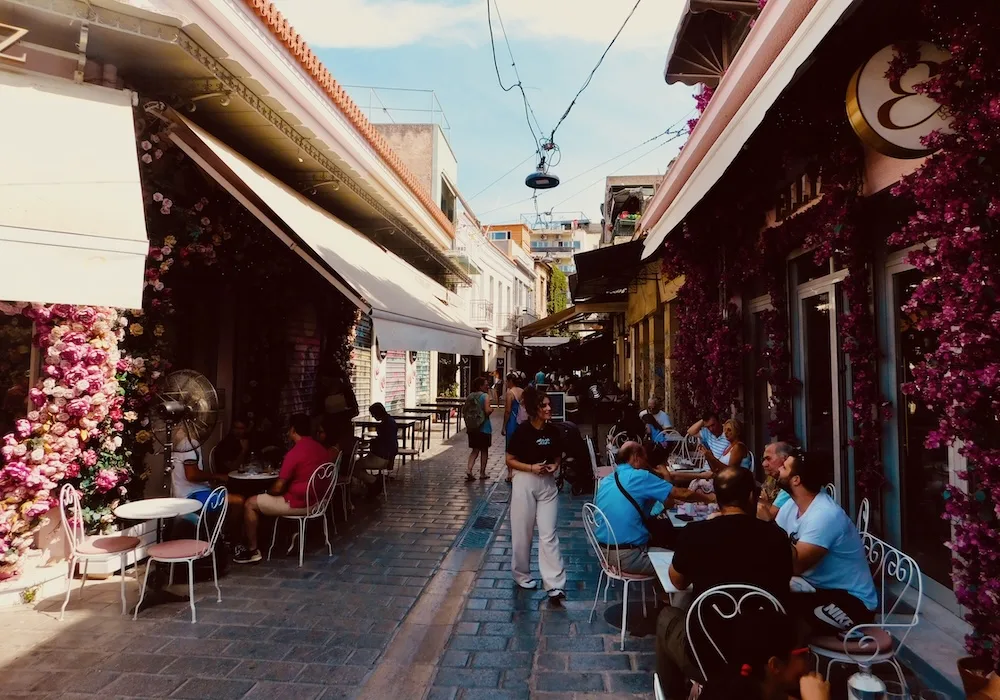
Make a point of checking it out on Sunday, when a flea market winds its way through the streets, tucked in between all the run-of-the-mill souvenir shops.
The few flea market stall owners we interacted with wouldn’t bargain. But Teen Traveler found a pretty antique ink pot that she bought to use as a jewelry box.
Thisiou Street was probably our favorite to explore. I bought sandals made onsite for €40 at Sandal Workshop by Argi V. The styles here were fun and a bit different than what I saw at the other sandal shops in the area.
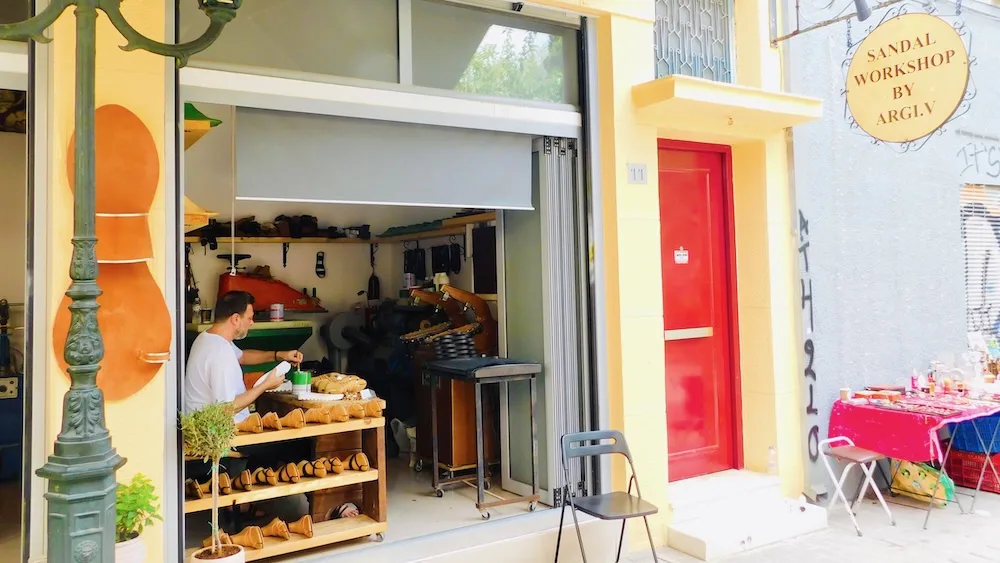
Two doors down we found Mon Coin, a pottery studio with fun crockery and tableware, and further still there’s a used bookshop where Teen Traveler bought inexpensive vintage postcards. At the other end of the street we found the shady Lit Café, where we took time to chill out with cold drinks.
Hidden Anafiotika
Our guidebook highly recommended a stroll through Anafiotika, a village of colorful Cycladic-style homes and a unique history within Plaka. But the landmarks it said to seek out were incorrect and we never found it.
Its heart seems to be along a circular portion of Stratonos Street. A good landmark to map out is the Holy Church of St. George of the Rock, which marks the start of it.
Official Syntagma Square
We didn’t go to Syntagma Square because there was no getting our teen interested in the changing of the guard at the palace or the Tomb of the Unknown Soldier.
If you have school-age or younger kids with you, I would head over that way though. Between the palace and the tomb is a large park with a small zoo, several gardens to wander in and escape the heat, a pond full of turtles and a large playground with cool wooden structures to climb up and slide down from.
Going to the Beach in Athens
I completely underestimated the extent to which Teen Traveler associated Greece with beaches. She was very disappointed that we didn’t set aside a beach day in Athens.
It’s hard to sacrifice a day of sightseeing to the beach when there’s so much to see. But if you’re traveling with a teen I recommend doing so, maybe even adding an extra day for this.
The guide books and websites we looked at suggested that there were only a handful of beaches and that they were far and hard to get to, requiring combinations of trains, buses and taxis.
But on our trip to Poseidon’s Temple, we began seeing beaches that looked acceptable as soon as we were on the outskirts of the city. They might have involved a train and trolley or taxi, but were far more accessible than our research suggested. The best way to locate the ones closest to towns is to search on Google Maps.
If you go, wear your bathing suit and bring towels, water, snacks, hats and sunscreen. Some had facilities and cafés nearby, but not all did.
Finding Great Food & Restaurants in Athens
It’s not hard to find good food in Athens, even in areas packed with tourists. You’ll find plenty of grilled meat, roast potatoes and French fries on menus which usually keep kids happy—Teen Traveler lived on gyros, roast chicken and fried calamari.
There are also gelato and ice cream shops everywhere in all the tourist neighborhoods. Most restaurants had Fanta or a local lemon or cherry sodas that Teen Traveler liked.
Greece is also a fairly easy place to be a vegetarian. You’ll find lots of salads, spreads like hummus and tzatziki with pita bread, and filo dough stuffed with combinations of spinach, cheese or potatoes. You can also find peppers or eggplant stuffed with rice. If you’re a pescatarian you’ll have even more options, given that Athens is coastal and seafood is a big part of Greek cuisine.
Plaka Restaurants
The Acropolis metro stop exits onto Makrigianni Street, which turns into Vyronos Street as it winds below the Acropolis. You’ll find crêperies, cafés, ice cream, gyro joints and stylish restaurants all along this strip.
• Diogenes has a warmly lit and inviting terrace that stretches behind the Choragic monument of Lysicrates where Vyronos runs into Sellei street. We liked it so much we ate there twice. And when we mentioned to the waiter we were returning for a second time, he thanked us and then gave us glasses of masticha, a sweet Greek apéritif on the house.
The first time we ate here, it was just Rich and I. We shared white bean hummus and a small pot of mussels flavored with orzo, chilis and fresh herbs. Our moussaka came in the clay pot it was baked in. It had eggplant and meat layered with a creamy béchamel sauce. It’s not a light dish and we didn’t finish it, but it was good.
I ordered the chicken and potatoes off the kids’ menu to take back Teen Traveler who was in the hotel sleeping off too much sun. It turned out to be plump chunks of hand-breaded fried chicken and crispy roast potatoes that she loved.
When we went back with her the next night, she and I both ordered the roast chicken, which came with the same roast potatoes and had a light, lemony sauce that made it summery.
The three of us also shared a sampler platter that had the white-bean hummus, tzatziki mixed with beets to make a bright purple, a traditional fish-roe spread that Rich liked and a garlicky-potato spread that was Teen Traveler’s favorite.
• The restaurant has a casual shop up the block, Diogenes Food Hall, where we popped in for lunch on another day. We picked out some spanakopita (spinach and feta in filo dough) and similar pies stuffed with lamb and chicken. A soda and two beers completed an inexpensive and quick lunch.
• We’re not keen on Greek desserts. So after dinner at Diogenes, we stopped into Kayak, a café with gourmet ice cream also along the same street. Teen Traveler opted for dark chocolate ice cream with raspberries, a favorite combination. I had vanilla studded with quince because I like this pear-like fruit and I’d never seen it in ice cream before. Both were rich, full-fat and delicious.
Monastiraki restaurants
We found plenty of cafés dotted around Monastiraki that had shaded patios where we could stop for cold soft drinks and maybe a snack when the heat became too much. There are also cheap gyro shops and casual sit-down restaurants. And ice cream shops, of course.

• Near the Monastiraki metro you’ll spot Hans & Gretel, a European chain of extremely colorful sweet shops inspired by the fairy tale. It’s known for chimney cake, a hollow log-shaped cinnamon cake that’s great for breakfast.
But it’s the candy and cotton candy and outrageous ice cream creations that draw kids inside. Start with a cone covered in sprinkles or tiny, bright nonpareils. Teen Travel added strawberry fizz ice cream, tiny chocolate cookies and a pastel-striped marshmallow. They always add a tiny cone on top to make your concoction look like a unicorn.
I went next store to DaVinci Gelato, which has a few locations around town. It has a grown-up, gourmet ambiance that is the polar opposite of its neighbor. I chose watermelon sorbet, which was extremely refreshing on a hot summer day.
• Adriano Street, which runs between Monastiraki Square and the Agora, is lined with restaurants. The food looked good at all of them and I imagine they’re mostly interchangeable. We chose a spot called Dia Tafta, mostly because it was busy but not packed and its patio had a lot of shade.
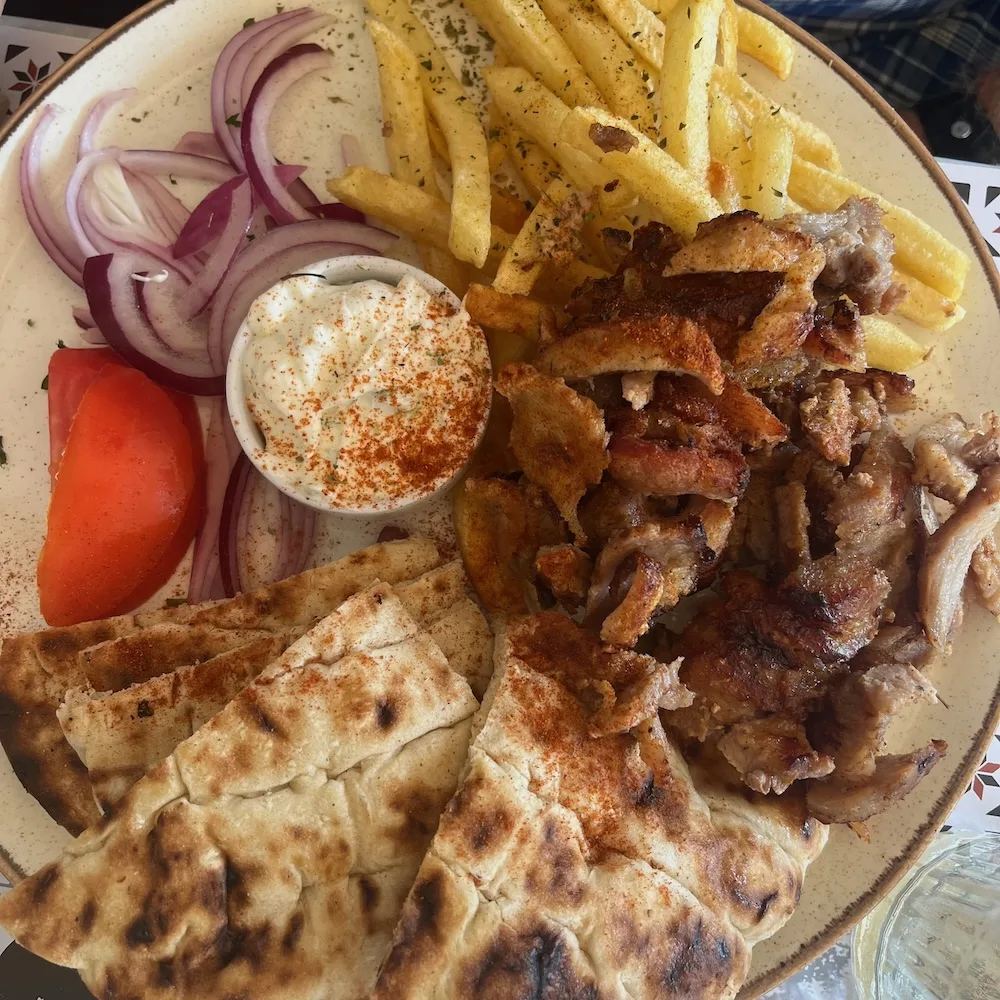
Rich and Teen Traveler ordered gyro platters that were delicious but huge; they could have easily shared one. I ordered peppers stuffed with rice and summer vegetables. It was good and a little bit lighter than their lunch.
Exarchia Restaurants
Exarchia has all kinds of bars, restaurants, vegetarian cafés and vegan bakeries tucked throughout the neighborhood. For a good concentration, head to Exarchia Square, which is actually a triangle.
• On our Sunday morning visit we stopped for coffee at Blue Bear Café, which had gorgeous animal murals on the wall and a friendly bartender. We liked the vibe, but the menu was all breakfast food and we were hoping for an early lunch.
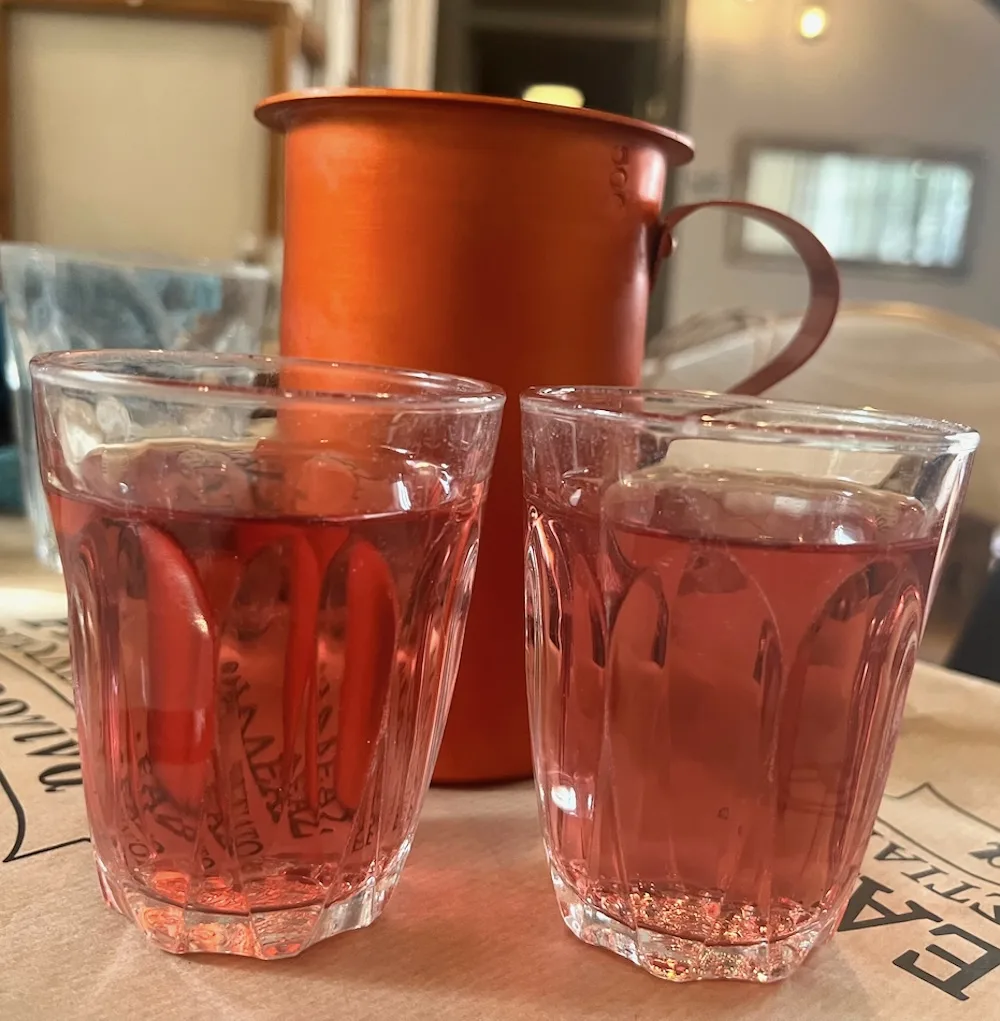
• Half a block from the Blue Bear we found a pedestrian plaza with a row of restaurants. We picked a place called Achilles Vergina because something on the sign made us think it was a Greek beer garden. It wasn’t actually, but it was one of our favorite meals.
We ordered fried zucchini, which only the Greeks know how to make correctly. Crisp zucchini sticks came with a bowl of tzatziki that was more lemony and less garlicky than most; we demolished it.
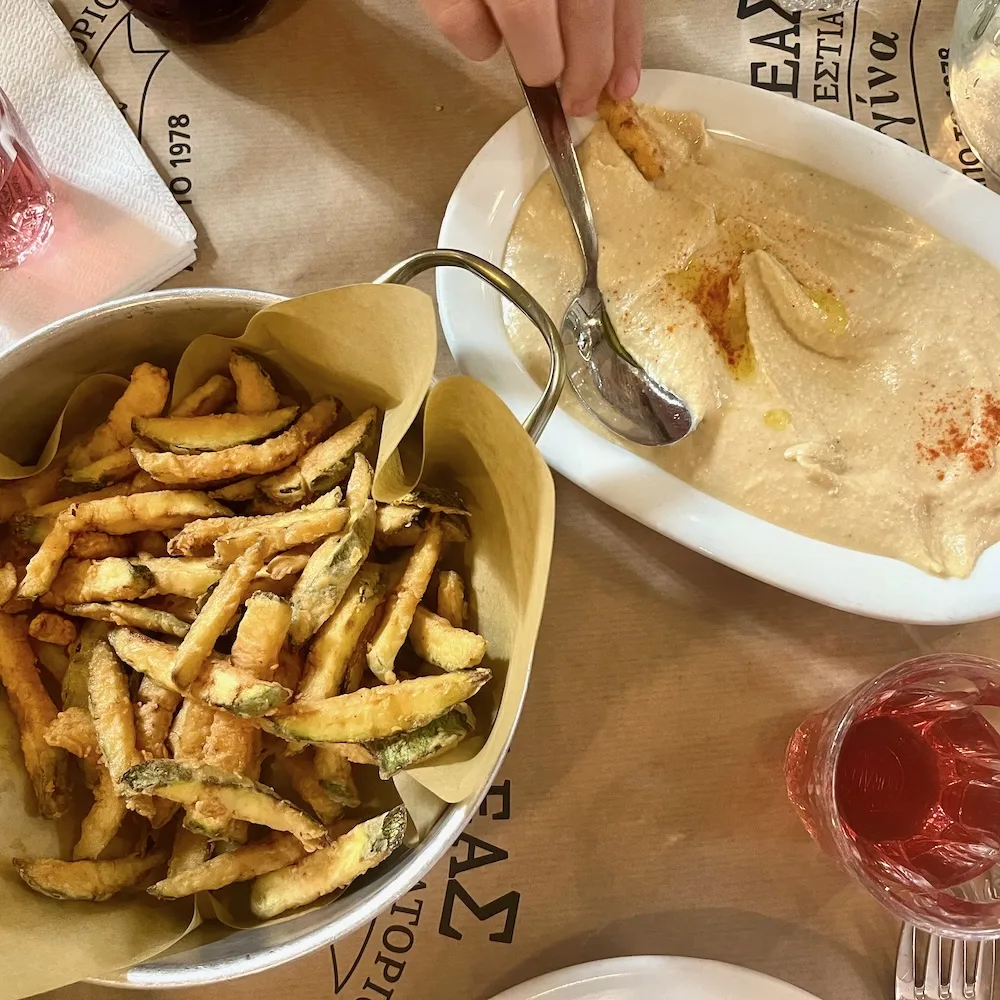
We also had fresh hummus and, learning from our previous lunch, shared a kebab platter that came with pita bread, fries and more tzatziki. We came away happy and full. And prices were a bit gentler than we found in Plaka and Monastiraki.
• We returned to Exarchia for breakfast on our last morning. We saw other families sitting under a big shady tree in front of Diplo Café and decided we’d follow the crowd. I had a good latté while Rich had his first real Greek coffee.
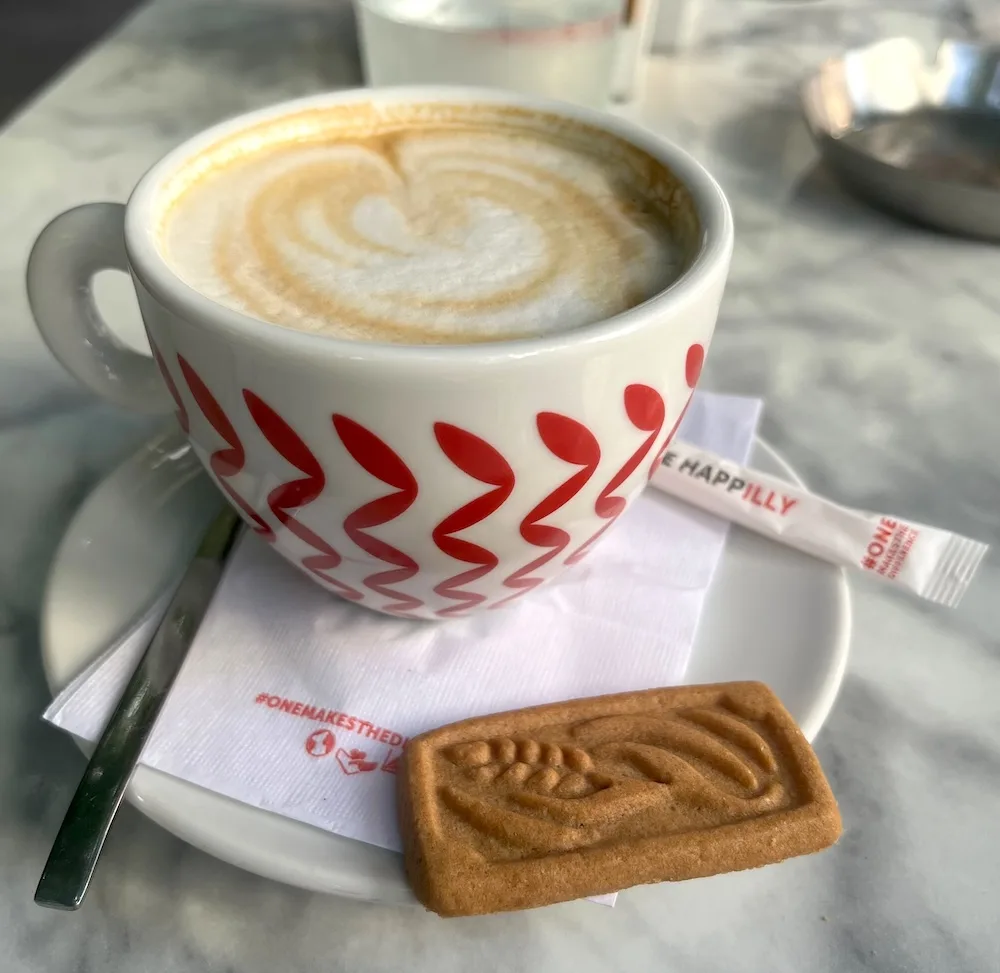
He and I both had edam-cheese toasties; mine with ham and his with turkey. They came with potato chips, which seemed funny for breakfast. But they were good and not too heavy. Teen Traveler had homemade lemonade and an omelet with chicken and potatoes.
Metaxourgeio Restaurants
• We got back from our Poseidon adventure around 9:00 pm and hoped Mironi Tavern, across from the hotel, would still be open. It was packed and we had to wait about 20 minutes for a table.
We ordered our Greek-taverna favorites: calamari, shrimp in garlic and lemon, tzatziki and fried zucchini. It was more food than we could eat (one less dish would have been fine). It was all good and we had live music playing for part of our meal.
• We went to the Bread Factory on three of the four mornings we were there. It’s large, busy and has good coffee and more pastries than we could possibly try in a few days. The chocolate cookies, croissants and sesame-seed-covered Greek bagels were all winners.
Basic Info for an Athens Vacation
Getting to Athens
Cruise ships dock in the Port of Piraeus, about eight miles from the center of Athens. It’s busy and if you aren’t taking a cruise-ship transfer to the airport or a tour with the cruise company, your best bet for getting into the city is a taxi.
It’s a good idea to tell them your destination and get a price before you head out. The taxis don’t have meters and the drivers can try to charge “tourist” prices. Fares to a central Athens hotel should be €25 to €35.
There are buses to Plaka and Monastiraki for less than €5 per person, which are probably manageable if you’re traveling light. But if you’re staying outside those neighborhoods, you’ll have to add a metro ride, too. For us, that combination would have added up to more than €20, so paying €30 for the ease of a cab ride was a better value.
You can take an express bus or a combination of Metro and suburban rail to and from the airport. A €20 tourist ticket includes round-trip transfers for the airport and three days of unlimited public transit rides. If you think you’ll use the Metro a lot, it’s probably a good deal.
Taxis to and from the airport should charge a flat fare, currently €40 or €42 during the day and €55 or €58 at night. Again, confirm before you get in the car so there are no misunderstandings.
Getting Around Athens
The Athens Metro has only three lines and is both cheap and easy to navigate. It’s a flat-fare system, which means it’s €1.40 no matter how far you go.

We were never sure how much we would take the metro versus walk around town, so we bought €2.80 round-trip fares whenever we needed the train, which worked out for us. If you’ll take at least four rides a day, a daily unlimited ticket is the way to go. If you’ll be in town for more than a weekend, a five-day unlimited is a great money-saver.
When you are crossing the street in Athens, keep in mind that every Greek driver believes he or she has the right of way. Yielding to pedestrians is unheard of. If you jaywalk, oncoming cars will use their horns, not their breaks. We learned very quickly to cross at the corners and follow the traffic lights.
Hot weather & hydration in Athens
Summer heat in Athens is no joke.
It took us two tries to get to the top of the Acropolis because on our first visit Teen Traveler became queasy with heat exhaustion halfway up the hill. We took her back to the hotel, where she drank a large glass of water and fell asleep.
Every morning, I would fill our water bottle to the top with ice. Just ice. Ninety minutes after we left the hotel, the ice would be completely melted and in a little more than two hours the water was warm.
We sometimes took the Metro for distances we would normally have walked to get out of the sun for a few minutes and cool down with a bit of AC.
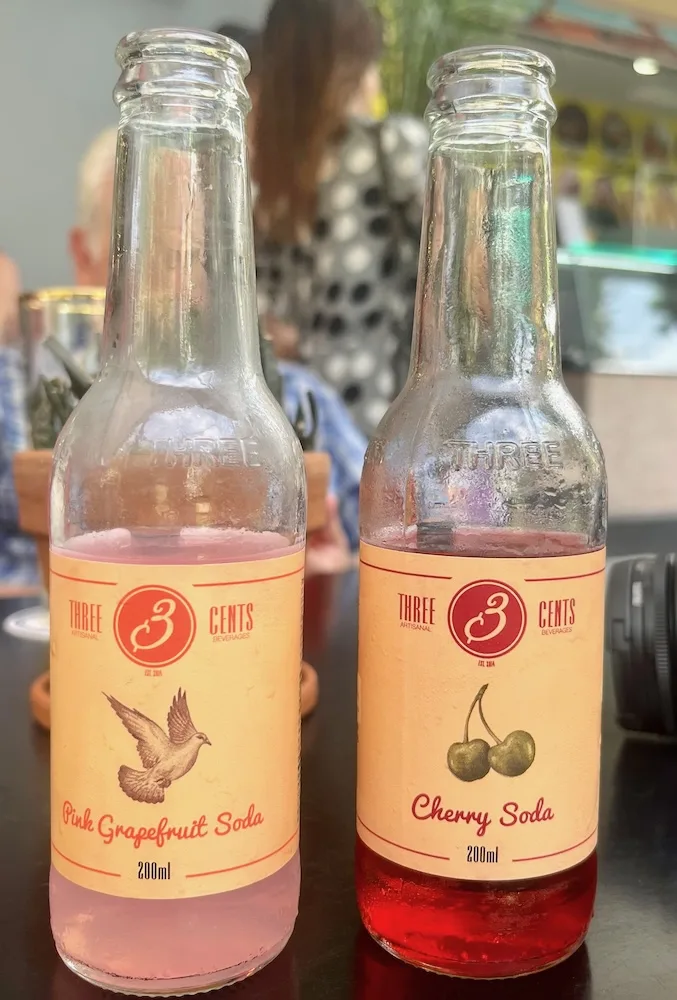
Bring water bottles and plan to refill them several times during the day. As often as you feel the need, take advantage of the cafés that are everywhere to sit in the shade with mineral water and soft drinks.
Pack sunhats and sunscreen and use them. Even if sunburn isn’t a worry for you, sunscreen and hats both help to keep heat exhaustion at bay.
What to pack for Greece
After sunhats, sunscreen and sunglasses, the most important thing to pack is comfortable shoes with ru soles. There are marble floors and sidewalks all over the place and they’re surprisingly slippery. If your shoes don’t have good treads you’ll almost certainly wipe out.
I know there are stylish parts of Athens, but in almost all the places we were, neat shorts, sundresses, t-shirts and spaghetti-strap tops were fine. Light long sleeves and light, loose pants are handy in the heat, too.
I had a cardigan for nighttime but never needed it.
Most Greek Orthodox churches expect women to cover their shoulders and head. Keep a scarf handy in case you wind up wanting to visit one and need to cover up. Men should be modest, too; pants are preferred; if you’re wearing shorts it’s better if they come to the knee.
A tip for cellular service
When a fellow traveler writer introduced me to Airalo, it was a where-have-you-been-all-my-life product.
Airalo is an app that provides virtual SIM cards, which allow you to access a local data network in the country you’re visiting without having to replace your physical SIM card.
Our cellular carrier charges us $5-$10/phone/day in roaming fees outside the U.S. In the five countries where I’ve used Airalo so far, I’ve been able to get all the data I need for about $5/phone/week. All three of us can use all the apps we want on a week-long trip for a total of $15 versus $35 to $70 with our carrier. That’s great value.
Pin it for later!
